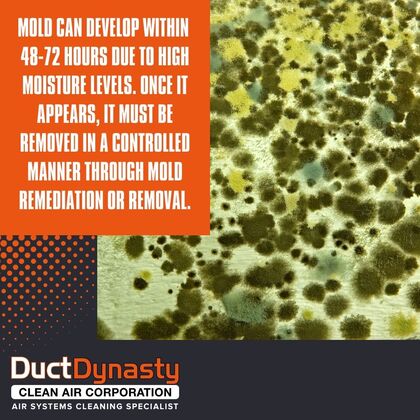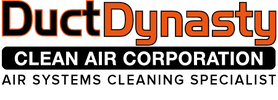 Mold can have a significant impact on commercial air ducts, posing both health and structural risks. As we move through the summer months, the increased rainfall and Florida’s humid climate create a breeding ground for mold. Mold growth must be professionally cleaned and remediated. However, it is crucial to focus on the damaged area and understand the impact on your HVAC system. Here are some key points to consider regarding the effect of mold on commercial air ducts: I. Health Concerns & Reduced Indoor Air Quality Mold spores released by contaminated air ducts can cause various health issues, especially for individuals with respiratory problems or weakened immune systems. These health problems include allergic reactions, respiratory infections, and asthma attacks. Mold growth inside air ducts can lead to the circulation of contaminated air throughout the building. A mold infestation can result in unpleasant odors, musty smells, and poor indoor air quality, negatively affecting occupants’ comfort and productivity. Mold growth in HVAC systems can lead to discomfort, such as dry skin and irritated eyes. Also, mold spores can cause respiratory problems, including coughing and wheezing. The allergic reactions associated with mildew are often called “sick building syndrome” because they are not typically caused by exposure to just one allergen but rather a combination of common indoor air pollutants. II. Duct Obstruction & Structural Damage Mold growth can obstruct the air ducts, restricting the flow of air. This obstruction can lead to inadequate airflow, uneven temperature distribution, and reduced HVAC system efficiency. Such issues can increase energy consumption and result in higher utility costs. In addition to health concerns and increased energy costs, duct obstruction can impact indoor air quality and cause various other problems. For example, mold growth can clog vents and drainage pipes, which may lead to water damage. Beyond obstructing the airflow of your system, mold can gradually deteriorate the structural integrity of air ducts. Mold growth within ductwork can lead to corrosion, weakening the metal and potentially causing leaks or holes. These damages may require costly repairs or even duct replacement. III. Liability and Legal Compliance For commercial buildings, it is essential to meet health and safety regulations. Failure to address mold issues promptly may lead to legal liability, fines, or even closures. Regular inspections, maintenance, and prompt mold remediation in air ducts are crucial to comply with regulations and ensure occupant safety. Mold growth can be a complex problem to remove from the ducts. As mold spreads and grows, it can become increasingly difficult to remove, so it is important to react quickly and hire a qualified professional. To minimize the impact of mold growth in commercial air ducts, it is essential to implement preventive measures such as regular system maintenance, effective moisture control, and prompt remediation of any signs of mold. Consulting with professionals experienced in commercial HVAC and mold remediation is recommended to ensure thorough assessment and proper mitigation. IV. Remediation Process Once mold is discovered, it requires fast-acting professional service to remove the infestation properly. The mold remediation process for commercial HVAC systems involves several steps to effectively remove and prevent mold growth. Here is a description of the typical process: Inspection: An initial inspection is conducted to identify areas where mold is present in the HVAC system. This includes checking the air ducts, cooling coils, drain pans, and other components. At Duct Dynasty, we use Flir Infrared camera technology for high-resolution thermal imaging to detect temperature variations in HVAC systems. This helps us to identify water damage and mold infestations clearly. Our process not only gives us a clear understanding of the health of commercial air ducts, but it also enables us to offer proactive maintenance by identifying potential equipment malfunctions before they cause costly breakdowns. This ensures uninterrupted HVAC operation and helps save on expensive repairs in the long run. Assessment: After identifying the mold, a thorough evaluation is conducted to determine the extent of the problem. This includes examining the severity of the contamination and identifying any underlying causes, such as leaks or excess moisture. Containment: To prevent the spread of mold spores to other areas of the building, containment measures are put in place. This may involve sealing off affected areas, using negative air pressure, and employing containment barriers. Air Filtration: High-efficiency particulate air (HEPA) filters are installed in the HVAC system to capture mold spores and prevent them from circulating in the air. This helps improve indoor air quality and reduces the risk of further contamination. Removal: Removing mold involves physically cleaning and disinfecting affected surfaces. In the case of HVAC systems, this may include cleaning air ducts, coils, drain pans, and other components using specialized equipment and cleaning solutions. Another essential part of the remediation process is Commercial Air Duct Sanitization. Air Duct Sanitization is a process of disinfecting and deodorizing ducts to kill any remaining bacteria, viruses, mold/mildew, and odors. By ensuring clean ducts, a house, and its occupants will benefit from residential indoor air quality. Drying and Dehumidification: The affected areas are thoroughly dried to address any moisture issues that contributed to mold growth. Commercial dehumidifiers may be used to reduce humidity levels and prevent future mold growth. Prevention: To prevent mold from returning, it is crucial to address the root causes. This may include repairing leaks, improving ventilation, and maintaining proper humidity levels. Regular inspections and maintenance of the HVAC system are also essential. Post-Remediation Verification: After the mold remediation process is completed, a final inspection is conducted to ensure that all mold has been effectively removed. This step is crucial to ensure the success of the remediation efforts. It is important to note that professionals with experience in this field should always carry out mold remediation for commercial HVAC systems to ensure proper handling and effective mold removal. Schedule Your Commercial Air Duct Cleaning Today If you discover mold in your facility, we can help. Contact Duct Dynasty, Central Florida’s premier air systems cleaning specialists, to learn more and schedule your commercial HVAC mold remediation or duct sanitization service. various health issues, especially for individuals with respiratory problems or weakened immune systems. These health problems include allergic reactions, respiratory infections, and asthma attacks. Mold growth inside air ducts can lead to the circulation of contaminated air throughout the building. A mold infestation can result in unpleasant odors, musty smells, and poor indoor air quality, negatively affecting occupants’ comfort and productivity. Mold growth in HVAC systems can lead to discomfort, such as dry skin and irritated eyes. Also, mold spores can cause respiratory problems, including coughing and wheezing. The allergic reactions associated with mildew are often called “sick building syndrome” because they are not typically caused by exposure to just one allergen but rather a combination of common indoor air pollutants. II. Duct Obstruction & Structural Damage Mold growth can obstruct the air ducts, restricting the flow of air. This obstruction can lead to inadequate airflow, uneven temperature distribution, and reduced HVAC system efficiency. Such issues can increase energy consumption and result in higher utility costs. In addition to health concerns and increased energy costs, duct obstruction can impact indoor air quality and cause various other problems. For example, mold growth can clog vents and drainage pipes, which may lead to water damage. Beyond obstructing the airflow of your system, mold can gradually deteriorate the structural integrity of air ducts. Mold growth within ductwork can lead to corrosion, weakening the metal and potentially causing leaks or holes. These damages may require costly repairs or even duct replacement. III. Liability and Legal Compliance For commercial buildings, it is essential to meet health and safety regulations. Failure to address mold issues promptly may lead to legal liability, fines, or even closures. Regular inspections, maintenance, and prompt mold remediation in air ducts are crucial to comply with regulations and ensure occupant safety. Mold growth can be a complex problem to remove from the ducts. As mold spreads and grows, it can become increasingly difficult to remove, so it is important to react quickly and hire a qualified professional. To minimize the impact of mold growth in commercial air ducts, it is essential to implement preventive measures such as regular system maintenance, effective moisture control, and prompt remediation of any signs of mold. Consulting with professionals experienced in commercial HVAC and mold remediation is recommended to ensure thorough assessment and proper mitigation. IV. Remediation Process Once mold is discovered, it requires fast-acting professional service to remove the infestation properly. The mold remediation process for commercial HVAC systems involves several steps to effectively remove and prevent mold growth. Here is a description of the typical process: Inspection: An initial inspection is conducted to identify areas where mold is present in the HVAC system. This includes checking the air ducts, cooling coils, drain pans, and other components. At Duct Dynasty, we use Flir Infrared camera technology for high-resolution thermal imaging to detect temperature variations in HVAC systems. This helps us to identify water damage and mold infestations clearly. Our process not only gives us a clear understanding of the health of commercial air ducts, but it also enables us to offer proactive maintenance by identifying potential equipment malfunctions before they cause costly breakdowns. This ensures uninterrupted HVAC operation and helps save on expensive repairs in the long run. Assessment: After identifying the mold, a thorough evaluation is conducted to determine the extent of the problem. This includes examining the severity of the contamination and identifying any underlying causes, such as leaks or excess moisture. Containment: To prevent the spread of mold spores to other areas of the building, containment measures are put in place. This may involve sealing off affected areas, using negative air pressure, and employing containment barriers. Air Filtration: High-efficiency particulate air (HEPA) filters are installed in the HVAC system to capture mold spores and prevent them from circulating in the air. This helps improve indoor air quality and reduces the risk of further contamination. Removal: Removing mold involves physically cleaning and disinfecting affected surfaces. In the case of HVAC systems, this may include cleaning air ducts, coils, drain pans, and other components using specialized equipment and cleaning solutions. Another essential part of the remediation process is Commercial Air Duct Sanitization. Air Duct Sanitization is a process of disinfecting and deodorizing ducts to kill any remaining bacteria, viruses, mold/mildew, and odors. By ensuring clean ducts, a house, and its occupants will benefit from residential indoor air quality. Drying and Dehumidification: The affected areas are thoroughly dried to address any moisture issues that contributed to mold growth. Commercial dehumidifiers may be used to reduce humidity levels and prevent future mold growth. Prevention: To prevent mold from returning, it is crucial to address the root causes. This may include repairing leaks, improving ventilation, and maintaining proper humidity levels. Regular inspections and maintenance of the HVAC system are also essential. Post-Remediation Verification: After the mold remediation process is completed, a final inspection is conducted to ensure that all mold has been effectively removed. This step is crucial to ensure the success of the remediation efforts. It is important to note that professionals with experience in this field should always carry out mold remediation for commercial HVAC systems to ensure proper handling and effective mold removal. Schedule Your Commercial Air Duct Cleaning Today If you discover mold in your facility, we can help. Contact Duct Dynasty, Central Florida’s premier air systems cleaning specialists, to learn more and schedule your commercial HVAC mold remediation or duct sanitization service.
1 Comment
10/25/2023 01:48:11 pm
Glad to have your expertise on mold. It is everywhere, and we have our share in Chicago. Less of a breeding ground but lots in attics and wet basements. The information here is quite helpful.
Reply
Leave a Reply. |
AuthorWrite something about yourself. No need to be fancy, just an overview. Archives
July 2024
Categories |
-
PROUDLY SERVING
CENTRAL FLORIDA -
FOR STATEWIDE SERVICE
888.489.9222 -
DROP US A LINE!
[email protected]

 RSS Feed
RSS Feed